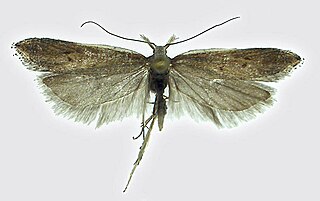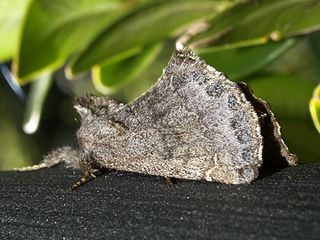
Agrotis is a genus of moths of the family Noctuidae. The genus was erected by Ferdinand Ochsenheimer in 1816. A number of the species of this genus are extinct.

Pygaerinae is a subfamily of the moth family Notodontidae, the silver prominents and relatives. The genus list is preliminary, as not all Notodontidae have been assigned to subfamilies yet.

Sophronia is a genus of moths in the family Gelechiidae.
Walter Karl Johann Roepke was a German entomologist who specialised in Lepidoptera and Coleoptera.

Die verwandelten Weiber, oder Der Teufel ist los, erster Teil is a three-act German: comische Oper by the German composer Johann Adam Hiller, incorporating 14 musical numbers from the popular farce Der Teufel ist los by Johann Georg Standfuß.

Eudonia is a large and widespread genus in the grass moth family (Crambidae), subfamily Scopariinae. There is no common name for the roughly 250 species placed here; new species are still being described regularly. Although the genus was proposed early in the 19th century, many of these moths were for a long time retained in Scoparia, the type genus of the subfamily and a close relative of Eudonia. A few small genera have been proposed for separation from Eudonia, but given the size of this group this is not particularly convincing; thus, all are retained here pending a comprehensive phylogenetic review.
Ammopolia is a genus of moths of the family Noctuidae.

Dichagyris is a genus of moths of the family Noctuidae. The former genera Loxagrotis, Pseudorichia, Pseudorthosia and Mesembragrotis are now considered subgenera of Dichagyris. From Greek dikha-gyris 'apart, asunder; double' + 'the finest meal or flour'; English pronunciation: /digh-kuh-JIGH-riss/, IPA [dɑj•kə'dʒɑj•ɹɪs].

Euxoa is a genus of moths of the family Noctuidae raised to Genus by the German entomologist, Jacob Hübner. The Genus is mostly confined to dry and semi dry areas in the Northern Hemisphere. There 130 species in Eurasia, a few in Africa, and 175 in North America. There are no species in the Genus in South-East Asia or in Australia. In North America, most species are found in Western regions. Of the North American species, 4 are endemic to Mexico. There is one species recorded from Chile, but this may be a mislabeled specimen. In real terms, species numbers do not equal species abundance. Some areas with few species have large numbers of the ones that do live there.

Pseudopanolis is a genus of moths of the family Noctuidae.

Standfussiana is a genus of moths of the family Noctuidae.
Albarracina is a genus of tussock moths in the family Erebidae.

Rhegmatophila alpina is a moth of the family Notodontidae. It is found in the Southern Alps, the Balkans and Spain.
Rhegmatophila ricchelloi is a moth of the family Notodontidae. It is found in Sardinia.

"Details of a Sunset" is a short story by Vladimir Nabokov written in Russian under his pen name Vladimir Sirin in Berlin in 1924.

Melanargia is a genus of butterflies belonging to the family Nymphalidae and the subfamily Satyrinae.

Mniotype adusta, the dark brocade, is a moth of the family Noctuidae. It was described by Eugenius Johann Christoph Esper in 1790. It is found throughout much of the Palearctic from Europe to Japan, China and Mongolia. It is also found in North America. The habitat consists of heathland, chalky downland, fenland, moorland and upland areas.

Melanargia larissa, the Balkan marbled white, is a butterfly in the family Nymphalidae. It is found from south-eastern Europe and Asia Minor to Transcaucasia and north-western Iran. The habitat consists of dry grasslands, scrubby hillsides and grassy woodland glades. Adults are on wing from mid-May to July in one generation per year.
Sophronia curonella is a moth of the family Gelechiidae. It was described by Max Standfuss in 1884. It is found in the Apennines in Italy.

Maximilian Rudolph Standfuss was a German-Swiss entomologist specializing in Lepidoptera.















